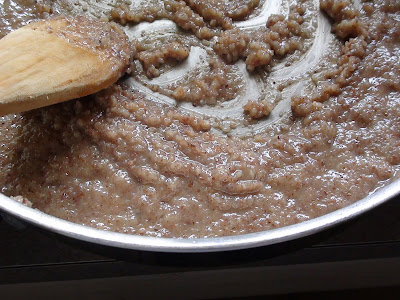The 1956 Hungarian Revolution was being put down by the Russian army. We were crammed into our communal shelter in the basement with eleven other families and with no access to food except what we had upstairs. Our house was surrounded by a beautiful courtyard. Taller buildings were sheltering it, except in one corner there was a one storey building exposing our second floor apartment. Through that we could see the steeple of the Rózsák Terei Szent Erzsébet Templom. Once in a while my grandmother dared the bombs and went up to the apartment. Then a little while later she would appear with something to eat. Grandma wouldn’t let my mother go up lest our apartment was demolished while mother was up there. I never considered my grandmother heroic, I just think that in life and death situations people instinctively know who is the least expandable, and a pregnant, twenty six year old mother of two is surely one.
Toward the end of our first week in the shelter, grandma brought down the most memorable thing; a large potato bread. She must have been given some yeast by one of the neighbours, because we had no ice box and a cake of fresh yeast would have gone bad by then. That or she made wild yeast which would explain why it took her several days to make the bread. Then our super, Mrs Kiss gave us a chunk of butter. I talked about that butter for years and how good it tasted. My mother one day told me that the butter was actually rancid… I suppose real hunger can make even the least edible things taste good. We were down in the shelter for more two and a half weeks during the heavy street fighting, but I got sick so we all went upstairs even while the Russian bombs were dropping around us. But that is another story.
My grandmother’s potato bread looked more like mine, still, I regret not asking for her recipe. It never came up; didn’t seem important at the time. For this reason I began to write down my own recipes. In a decade or two who knows if anyone would remember, including me if there was a me.
To get the bread to look like this, [this is my second loaf in two days] the dough has to be soft and quite sticky; not from moisture content, but from the fully developed gluten. If all at once you pile the ingredients into the bowl, you will never be able to develop the same dough and your bread will not look anything like this. So don’t take shortcuts. This really is a wonderful bread!
HUNGARIAN POTATO BREAD
2 large russet potatoes, with the skin on
1 Tbsp salt
2 Tbsp extra virgin olive oil
1-1/2 tsp dried instant yeast
3 cups bread flour
all purpose flour for dusting
spray bottle of water
• Scrub the potatoes and cut them into 1 inch chunks. Do not peel, you will loose a lot of the flavour that way.
• Place the chopped potatoes in a medium saucepan and cover with water.
• Bring to a boil, then reduce heat and simmer until tender.
• Meanwhile, measure out 3 cups of bread flour and set it aside.
• Drain the potatoes, but save 1/2 cup of potato water for use later. Set the half cup of potato water aside to cool, the rest can be discarded.
• Let the potatoes and the potato water cool down completely before proceeding with the recipe.
• After they cooled down, mash the potatoes and add to the mixing bowl.
• Add the salt, the oil, the yeast, the reserved potato water and 1 cup of bread flour.
• With the paddle attachment beat for five minutes on medium speed.
• After five minutes the dough will be very elastic.
• Change to a dough hook and begin to add the remaining flour, but only half a cup at the time.
• Beat the dough again until very elastic. Add half a cup of flour. Keep beating and adding half a cup until all the flour is gone.
• Beat the dough for 5 minutes longer. Dough should be very elastic and sticky.
• Pull the dough from the bowl onto a floured surface and form into a ball. Place ball in an oiled, medium bowl and cover with a tea towel.
• Let dough proof in a warm room until doubled in size.
Place the dough on a floured surface and flatten it with your hands.
• Form dough into a rectangle and, starting with a short end, roll dough away from you into a tight log. This is the part that will give you the nice big holes.
• Stop rolling just before the log is sealed, and then flatten the remaining inch of dough with your fingers.
• Dust it with flour. This will prevent the loaf from fully sealing and will cause the seam to open slightly while baking. It didn’t do it for me the second time I tried it, because I allowed the dough to rise longer.
• Line a baking sheet with parchment paper. Sprinkle it with flour.
• Place the loaf, with seam side down, on the prepared pan.
• Sprinkle the top with a little flour and let the loaf rise until doubled.
• Dough will rise slightly and feel spongy to the touch.
• Preheat the oven to 400F.
• Just before moving loaf into the oven, mist the inside of oven with a spray bottle of water.
• Carefully flip over the loaf with seam side up, on the baking sheet. Since the dough didn’t open up for me, flipping the dough seemed redundant, however I really liked the funky shape I got from it so I will continue to use the same method of shaping. I was thinking it might look rather cool if I twisted the loaf mid section when I flipped it over… Maybe next time.
• Place the loaf in the oven and bake it for 45 minutes, misting the oven one more time after the first 5 minutes.
• The finished loaf will be dark brown and sound hollow when tapped on the bottom.
• Let it cool on a wire rack for 30 minutes if you can.
• To store the bread, wrap it in a clean kitchen towel. Never put homey breads in plastic bags. Plastic changes the texture, makes everything soft and you don't want to loose the crusty, chewy wonder that it is. I wrapped mine into a tea towel last night. The end slice dried ever so little, still delicious though, but the rest of the bread retained it lovely texture.










































